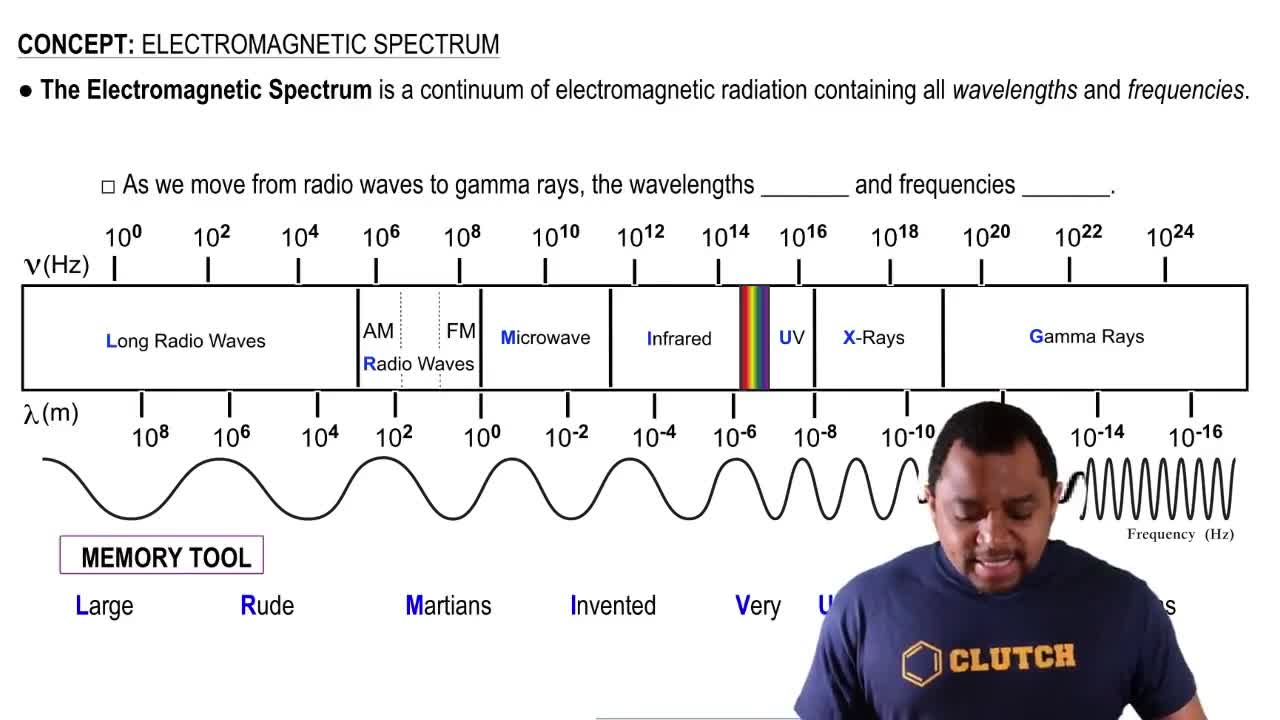Label each of the following statements as true or false. a. Visible light is a form of electromagnetic radiation.
Ch.6 - Electronic Structure of Atoms

Brown15th EditionChemistry: The Central ScienceISBN: 9780137542970Not the one you use?Change textbook
Chapter 6, Problem 15b
Label each of the following statements as true or false. b. Ultraviolet light has longer wavelengths than visible light.
 Verified step by step guidance
Verified step by step guidance1
Understand the electromagnetic spectrum, which includes different types of electromagnetic radiation arranged by wavelength.
Recall that ultraviolet (UV) light and visible light are both part of the electromagnetic spectrum.
Know that the electromagnetic spectrum is arranged from longer wavelengths to shorter wavelengths: radio waves, microwaves, infrared, visible light, ultraviolet, X-rays, and gamma rays.
Recognize that visible light has wavelengths ranging approximately from 400 nm (violet) to 700 nm (red).
Identify that ultraviolet light has shorter wavelengths than visible light, typically ranging from about 10 nm to 400 nm.

Verified video answer for a similar problem:
This video solution was recommended by our tutors as helpful for the problem above.
Video duration:
1mWas this helpful?
Key Concepts
Here are the essential concepts you must grasp in order to answer the question correctly.
Electromagnetic Spectrum
The electromagnetic spectrum encompasses all types of electromagnetic radiation, arranged by wavelength. It includes gamma rays, X-rays, ultraviolet light, visible light, infrared radiation, microwaves, and radio waves. Understanding the spectrum is crucial for distinguishing between different types of light and their properties.
Recommended video:
Guided course

Electromagnetic Spectrum
Wavelength and Frequency
Wavelength is the distance between successive peaks of a wave, while frequency is the number of waves that pass a point in one second. These two properties are inversely related; as wavelength increases, frequency decreases. This relationship is fundamental in understanding the characteristics of different types of light.
Recommended video:
Guided course

Frequency-Wavelength Relationship
Visible Light Range
Visible light is the portion of the electromagnetic spectrum that can be detected by the human eye, typically ranging from about 400 nm (violet) to 700 nm (red). Ultraviolet light, which lies just beyond the visible spectrum, has shorter wavelengths (10 nm to 400 nm) than visible light, making the statement in the question false.
Recommended video:
Guided course

Visible Light Spectrum
Related Practice
Textbook Question
Textbook Question
Label each of the following statements as true or false. c. X rays travel faster than microwaves.
Textbook Question
Label each of the following statements as true or false. a. The frequency of radiation increases as the wavelength increases. b. Electromagnetic radiation travels through a vacuum at a constant speed, regardless of wavelength. c. Infrared light has higher frequencies than visible light. d. The glow from a fireplace, the energy within a microwave oven, and a foghorn blast are all forms of electromagnetic radiation.
Textbook Question
Arrange the following kinds of electromagnetic radiation in order of increasing wavelength: infrared light, green light, red light, radio waves, X rays, ultraviolet light.
